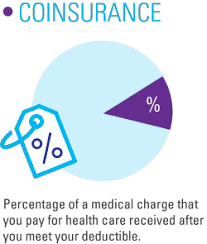
What is Coinsurance?
 Unlike your car insurance, homeowner’s and renter’s insurance which often cover 100% of your costs once you hit your deductible, health insurance is different – coinsurance.
Unlike your car insurance, homeowner’s and renter’s insurance which often cover 100% of your costs once you hit your deductible, health insurance is different – coinsurance.
Instead, most health insurance plans split the costs of your medical care between you and your health insurance for a brief period of time after you hit your deductible—usually through a cost-sharing method called coinsurance.
Before We Talk About Coinsurance
Like your doctor’s handwriting, health insurance is very complex and difficult to understand. You can easily get lost in a maze of lingo and jargon that makes your eyes roll back.
Before we dive into coinsurance, here’s a quick list of terms to help you as we navigate how it ties in with your health insurance plan:
Deductible: This is how much you’re expected to pay for medical expenses during the year before your health insurance starts to kick in.
Out-of-pocket maximum: This is the most you will have to spend on health care in a year before your insurance plan picks up 100% of the rest.
Copay (or copayment): This is the flat rate you pay for specific health care services like walk-in clinics, doctor visits or prescriptions.
What Is Coinsurance?
As mentioned earlier, coinsurance is the percentage of health care services you’re responsible for paying after you’ve hit your deductible for the year. With coinsurance, you’re sharing the cost of medical services with your health insurance plan until you reach your out-of-pocket maximum.
When you look at your policy, you’ll see your coinsurance shown as a fraction—something like 80/20 or 70/30. Most folks are used to having a standard 80/20 coinsurance policy, which means you’re responsible for 20% of your medical expenses and your health insurance plan will handle the remaining 80%.
Health plans with higher coinsurance usually have lower monthly premiums. That’s because you’re taking on more risk. So you’ll find that most health plans with 70/30 coinsurance have lower premiums than an 80/20 plan.
So, if you’re mostly healthy and have a good emergency fund in place, it might be a good idea to look for a health plan with higher coinsurance.
How Does Coinsurance Work?
It may help to think of how you pay for health care expenses in phases. How much you’ll pay depends on what phase you’re in.
Phase 1: The Deductible
Before your insurance kicks in, you’re going to have to pay for all of your medical costs until you hit your deductible. So, if you have an insurance policy with a $1,000 deductible, that’s how much you’ll spend on medical expenses before you get help from insurance.
That’s why it’s important to have enough money in savings to cover your deductible if you need to. Having a fully funded emergency fund or consistently putting money into a health savings account (HSA) if you have one could help you cover health costs during this deductible phase.
Phase 2: The Coinsurance
At this point, your health insurance will come in and help you pay for a big chunk of your health expenses for the rest of the year while you pay your coinsurance rate.
Let’s say you’ve already hit your deductible earlier in the year and, during a flag football game this month, you take that “break a leg” advice a little too literally.
After a visit to the emergency room, you get an X-ray and they put a cast on your broken leg. After all the treatment, the total cost of all the new health services received is $2,500.
If you have an 80/20 coinsurance plan, you’ll be responsible for 20% of the $2500 bill ($500) and your health insurance will take care of the rest.
You’ll keep paying your coinsurance rate of medical expenses for the year until you reach your out-of-pocket maximum.
Phase 3: The Out-of-Pocket Maximum
Once you hit your out-of-pocket maximum, you’re done. Your insurance plan will pay for 100% of the rest of your covered medical expenses for the year, and all you have to do is keep paying your premiums.
Remember that your deductible and each of the three phases reset each year, so make sure you consider that with timing any needed treatments.